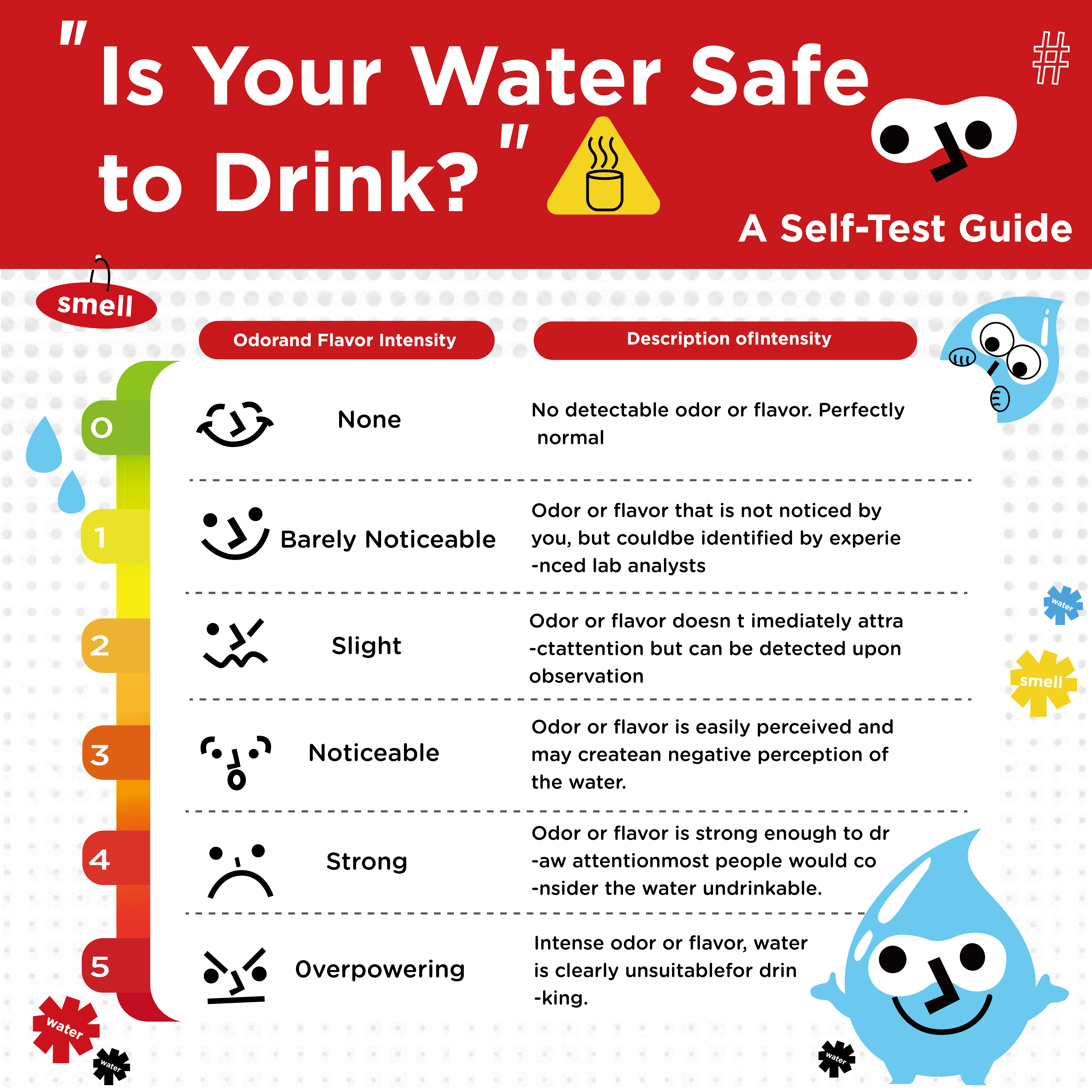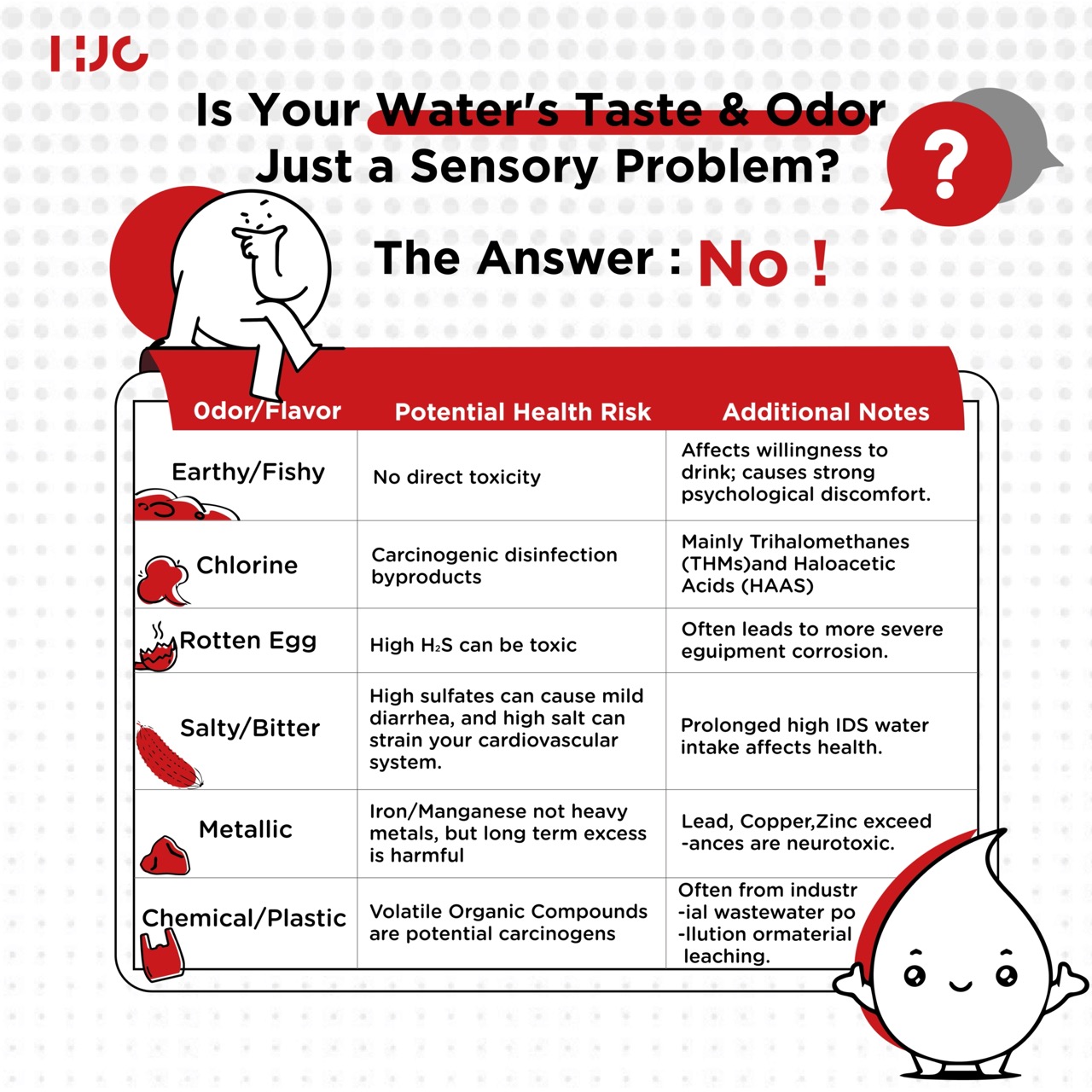For the most part, it's hard to judge the safety of your drinking water on your own. But your senses can detect its sensory qualities — like odor, taste, turbidity, and color.It's natural to be suspicious of water that looks dirty, discolored, or has an unpleasant smell or taste—even if these qualities aren't directly harmful.That’s why the appearance, taste, and smell of drinking water must be acceptable to consumers.Delivering this quality water is our top priority.Curious how your water compares? Use the guide below to identify common tastes and odors you might notice at home.

Why Does Water Have Unpleasant Tastes and Odors?
In theory, pure H₂O has no taste or smell. But in reality, water picks up a variety of substances on its way from the source through the distribution network to your tap — from chemical compounds and microbial byproducts to corrosion from old pipes or byproducts of chlorine treatment. Even trace amounts of these contaminants can be enough for the human senses to detect, leading to unpleasant tastes and odors.
Sources of Odors in Water — What’s Behind the Smell?
1. Earthy, Musty, or Fishy Smell — Natural Organic Compounds
If your water smells like damp soil, mold, or even fish, the likely culprits are Geosmin and 2-Methylisoborneol (2-MIB). These compounds are byproducts of microorganisms like blue-green algae and actinomycetes, with concentrations often peaking during summer algal blooms.While harmless to human health, they drastically impact how acceptable the water tastes and smells.Fun fact: Humans can detect Geosmin at levels as low as 10 parts per trillion (0.01 μg/L) — incredibly sensitive.
Solution:Activated carbon filtration or reverse osmosis (RO) are effective for removal.
2. Chlorine Smell — A Side Effect of Disinfection
The bleach-like smell in tap water comes from chlorine or chloramine, used to disinfect municipal water supplies. While essential for killing harmful microbes, even low levels (around 0.2–0.6 mg/L) can be detected by sensitive individuals. Beyond the sharp odor, excess chlorine can react with organic matter in water to form disinfection byproducts like trihalomethanes (THMs), which are potential carcinogens.THMs are regulated in municipal water supplies, but long-term exposure at high levels poses risks.
Solution:Activated carbon filtration or reverse osmosis (RO) are effective methods for removing these compounds.
3. Rotten Egg Smell — A Warning Sign of Hydrogen Sulfide (H₂S)
If your water smells like rotten eggs, hydrogen sulfide is usually to blame. It forms in anaerobic conditions where sulfate-reducing bacteria thrive — commonly in deep wells, stagnant pipelines, or especially in hot water systems. Beyond the awful smell, H₂S is highly corrosive to metal components like pipes, water heaters, and tanks. While low concentrations mostly affect odor, very high levels — particularly when released as gas in enclosed areas — can be hazardous through inhalation.
Solution: Treatment options include aeration, catalytic activated carbon (Centaur), manganese greensand (MGS) filtration, or pre-chlorination to
oxidize the H₂S.
4. Chemical or Plastic-Like Odor — Possible Wastewater Contamination
A sharp chemical smell — sometimes described as plastic-like or phenolic — can be a serious red flag. This often indicates contamination from industrial discharge, leaking pipelines, or wastewater intrusion into the supply. Along with the unpleasant smell, it may introduce volatile organic compounds (VOCs) and other harmful substances into your water.In newly installed plumbing, a temporary plastic-like odor may also arise from materials leaching — usually harmless and fading over time.
Solution: Activated carbon can absorb many of these compounds. For more serious contamination, a reverse osmosis (RO) system provides deep filtration and protection.
Taste Issues in Water — What’s Causing It?
1.Salty or Bitter Taste — High Total Dissolved Solids (TDS)
If your water tastes salty or bitter, the most common reason is elevated TDS. This means the water contains excessive levels of dissolved salts like sodium chloride (NaCl) or sulfates such as sodium sulfate (Na₂SO₄) and magnesium sulfate (MgSO₄). Taste issues typically become noticeable when TDS goes above 500 ppm, and levels above 1000 ppm might cause mild digestive discomfort, particularly in sensitive groups like children or the elderly.
Solution: Desalination systems — such as reverse osmosis (RO) or deionization (DI) — effectively remove excess salts.
2. Metallic Taste — Pipe Corrosion & Groundwater Minerals
A sharp, metallic flavor usually points to high levels of iron, manganese, copper, or zinc in your water. This often happens when aging pipes corrode, or when groundwater naturally contains elevated mineral levels. Not only does it affect taste strongly, but it can also leave reddish stains, discolor laundry, and lead to scale buildup in your plumbing.
Solution: Specialized filtration like Ecomix, BIRM, or manganese greensand (MGS). For comprehensive protection, RO systems also effectively remove metals.
3. Chemical / Plastic / Medicinal Taste – A Sign of Man-Made Pollution
Water that tastes like chemicals, plastic, or medicine isn’t just unpleasant — it’s a serious warning sign. This often means the water has been contaminated by industrial wastewater, pipeline corrosion, or plastic materials leaching chemicals into the water. Common pollutants include styrene, phenols, or hydrocarbons, all classified as volatile organic compounds (VOCs) — and many carry long-term health risks.These compounds are rarely found in treated municipal water but can occur due to system failures or illegal discharge.
Solution: Activated carbon filtration is highly effective for taste and odor removal. In cases of serious contamination, a combination of RO and advanced filtration is recommended for deep purification.
4.Alkaline Taste – Caused by High Alkalinity
If your water feels slippery, leaves a soapy aftertaste, or has a chalky flavor, it’s probably due to high alkalinity. This happens when there’s an excess of carbonates, bicarbonates, or hydroxides in the water. While not usually harmful, it can lead to dry skin, spotty dishes, and scale buildup in appliances like kettles and heaters — plus it just doesn’t taste good.
Solution: Reverse osmosis (RO) or deionization (cation exchange) systems are effective for reducing alkalinity and improving water quality.
While we can't solely rely on sight or taste to confirm drinking water safety, sensory characteristics like odor, taste, turbidity, and color are often the first "warning lights."
But remember: "Odorless" doesn't mean "harmless." Some dangerous substances (like arsenic, lead, or pesticides) can pose health threats even if you can't detect them with your senses. Also, one taste can mask multiple problems, like the simultaneous presence of chlorine, hydrogen sulfide, or volatile organic compounds, making it hard to identify all risks by taste alone.
If you recognize 3 or more issues from the list above, it’s time to test your water!
Choose the right purification method — such as activated carbon, reverse osmosis, or aeration — to ensure clean, safe water for your home.


